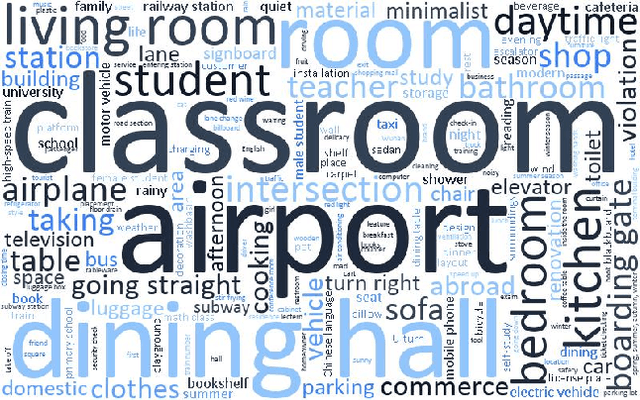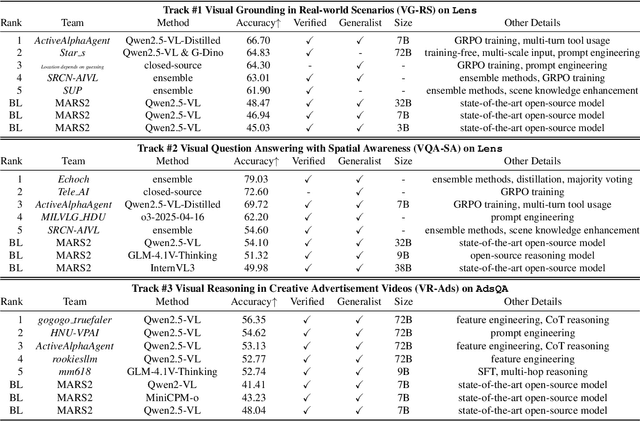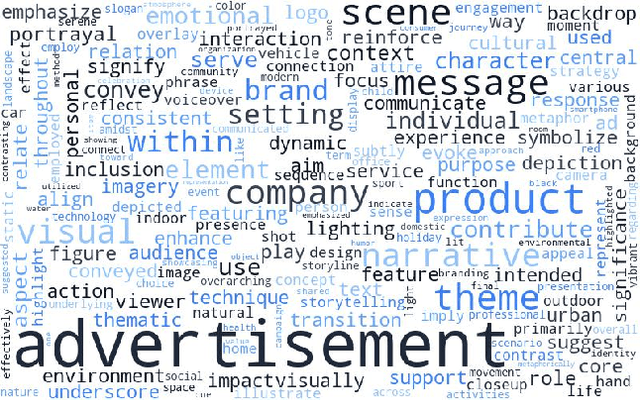Luc Van Gool
KU Leuven/ESAT-PSI, ETH Zurich/CVL, TRACE vzw
Multimodal Spatial Reasoning in the Large Model Era: A Survey and Benchmarks
Oct 29, 2025Abstract:Humans possess spatial reasoning abilities that enable them to understand spaces through multimodal observations, such as vision and sound. Large multimodal reasoning models extend these abilities by learning to perceive and reason, showing promising performance across diverse spatial tasks. However, systematic reviews and publicly available benchmarks for these models remain limited. In this survey, we provide a comprehensive review of multimodal spatial reasoning tasks with large models, categorizing recent progress in multimodal large language models (MLLMs) and introducing open benchmarks for evaluation. We begin by outlining general spatial reasoning, focusing on post-training techniques, explainability, and architecture. Beyond classical 2D tasks, we examine spatial relationship reasoning, scene and layout understanding, as well as visual question answering and grounding in 3D space. We also review advances in embodied AI, including vision-language navigation and action models. Additionally, we consider emerging modalities such as audio and egocentric video, which contribute to novel spatial understanding through new sensors. We believe this survey establishes a solid foundation and offers insights into the growing field of multimodal spatial reasoning. Updated information about this survey, codes and implementation of the open benchmarks can be found at https://github.com/zhengxuJosh/Awesome-Spatial-Reasoning.
EReLiFM: Evidential Reliability-Aware Residual Flow Meta-Learning for Open-Set Domain Generalization under Noisy Labels
Oct 14, 2025



Abstract:Open-Set Domain Generalization (OSDG) aims to enable deep learning models to recognize unseen categories in new domains, which is crucial for real-world applications. Label noise hinders open-set domain generalization by corrupting source-domain knowledge, making it harder to recognize known classes and reject unseen ones. While existing methods address OSDG under Noisy Labels (OSDG-NL) using hyperbolic prototype-guided meta-learning, they struggle to bridge domain gaps, especially with limited clean labeled data. In this paper, we propose Evidential Reliability-Aware Residual Flow Meta-Learning (EReLiFM). We first introduce an unsupervised two-stage evidential loss clustering method to promote label reliability awareness. Then, we propose a residual flow matching mechanism that models structured domain- and category-conditioned residuals, enabling diverse and uncertainty-aware transfer paths beyond interpolation-based augmentation. During this meta-learning process, the model is optimized such that the update direction on the clean set maximizes the loss decrease on the noisy set, using pseudo labels derived from the most confident predicted class for supervision. Experimental results show that EReLiFM outperforms existing methods on OSDG-NL, achieving state-of-the-art performance. The source code is available at https://github.com/KPeng9510/ERELIFM.
Lost in Translation? Vocabulary Alignment for Source-Free Domain Adaptation in Open-Vocabulary Semantic Segmentation
Sep 18, 2025



Abstract:We introduce VocAlign, a novel source-free domain adaptation framework specifically designed for VLMs in open-vocabulary semantic segmentation. Our method adopts a student-teacher paradigm enhanced with a vocabulary alignment strategy, which improves pseudo-label generation by incorporating additional class concepts. To ensure efficiency, we use Low-Rank Adaptation (LoRA) to fine-tune the model, preserving its original capabilities while minimizing computational overhead. In addition, we propose a Top-K class selection mechanism for the student model, which significantly reduces memory requirements while further improving adaptation performance. Our approach achieves a notable 6.11 mIoU improvement on the CityScapes dataset and demonstrates superior performance on zero-shot segmentation benchmarks, setting a new standard for source-free adaptation in the open-vocabulary setting.
MARS2 2025 Challenge on Multimodal Reasoning: Datasets, Methods, Results, Discussion, and Outlook
Sep 17, 2025



Abstract:This paper reviews the MARS2 2025 Challenge on Multimodal Reasoning. We aim to bring together different approaches in multimodal machine learning and LLMs via a large benchmark. We hope it better allows researchers to follow the state-of-the-art in this very dynamic area. Meanwhile, a growing number of testbeds have boosted the evolution of general-purpose large language models. Thus, this year's MARS2 focuses on real-world and specialized scenarios to broaden the multimodal reasoning applications of MLLMs. Our organizing team released two tailored datasets Lens and AdsQA as test sets, which support general reasoning in 12 daily scenarios and domain-specific reasoning in advertisement videos, respectively. We evaluated 40+ baselines that include both generalist MLLMs and task-specific models, and opened up three competition tracks, i.e., Visual Grounding in Real-world Scenarios (VG-RS), Visual Question Answering with Spatial Awareness (VQA-SA), and Visual Reasoning in Creative Advertisement Videos (VR-Ads). Finally, 76 teams from the renowned academic and industrial institutions have registered and 40+ valid submissions (out of 1200+) have been included in our ranking lists. Our datasets, code sets (40+ baselines and 15+ participants' methods), and rankings are publicly available on the MARS2 workshop website and our GitHub organization page https://github.com/mars2workshop/, where our updates and announcements of upcoming events will be continuously provided.
PANORAMA: The Rise of Omnidirectional Vision in the Embodied AI Era
Sep 16, 2025Abstract:Omnidirectional vision, using 360-degree vision to understand the environment, has become increasingly critical across domains like robotics, industrial inspection, and environmental monitoring. Compared to traditional pinhole vision, omnidirectional vision provides holistic environmental awareness, significantly enhancing the completeness of scene perception and the reliability of decision-making. However, foundational research in this area has historically lagged behind traditional pinhole vision. This talk presents an emerging trend in the embodied AI era: the rapid development of omnidirectional vision, driven by growing industrial demand and academic interest. We highlight recent breakthroughs in omnidirectional generation, omnidirectional perception, omnidirectional understanding, and related datasets. Drawing on insights from both academia and industry, we propose an ideal panoramic system architecture in the embodied AI era, PANORAMA, which consists of four key subsystems. Moreover, we offer in-depth opinions related to emerging trends and cross-community impacts at the intersection of panoramic vision and embodied AI, along with the future roadmap and open challenges. This overview synthesizes state-of-the-art advancements and outlines challenges and opportunities for future research in building robust, general-purpose omnidirectional AI systems in the embodied AI era.
Incremental Object Detection with Prompt-based Methods
Aug 20, 2025Abstract:Visual prompt-based methods have seen growing interest in incremental learning (IL) for image classification. These approaches learn additional embedding vectors while keeping the model frozen, making them efficient to train. However, no prior work has applied such methods to incremental object detection (IOD), leaving their generalizability unclear. In this paper, we analyze three different prompt-based methods under a complex domain-incremental learning setting. We additionally provide a wide range of reference baselines for comparison. Empirically, we show that the prompt-based approaches we tested underperform in this setting. However, a strong yet practical method, combining visual prompts with replaying a small portion of previous data, achieves the best results. Together with additional experiments on prompt length and initialization, our findings offer valuable insights for advancing prompt-based IL in IOD.
From Scan to Action: Leveraging Realistic Scans for Embodied Scene Understanding
Jul 23, 2025Abstract:Real-world 3D scene-level scans offer realism and can enable better real-world generalizability for downstream applications. However, challenges such as data volume, diverse annotation formats, and tool compatibility limit their use. This paper demonstrates a methodology to effectively leverage these scans and their annotations. We propose a unified annotation integration using USD, with application-specific USD flavors. We identify challenges in utilizing holistic real-world scan datasets and present mitigation strategies. The efficacy of our approach is demonstrated through two downstream applications: LLM-based scene editing, enabling effective LLM understanding and adaptation of the data (80% success), and robotic simulation, achieving an 87% success rate in policy learning.
Spatial-Temporal Graph Mamba for Music-Guided Dance Video Synthesis
Jul 09, 2025



Abstract:We propose a novel spatial-temporal graph Mamba (STG-Mamba) for the music-guided dance video synthesis task, i.e., to translate the input music to a dance video. STG-Mamba consists of two translation mappings: music-to-skeleton translation and skeleton-to-video translation. In the music-to-skeleton translation, we introduce a novel spatial-temporal graph Mamba (STGM) block to effectively construct skeleton sequences from the input music, capturing dependencies between joints in both the spatial and temporal dimensions. For the skeleton-to-video translation, we propose a novel self-supervised regularization network to translate the generated skeletons, along with a conditional image, into a dance video. Lastly, we collect a new skeleton-to-video translation dataset from the Internet, containing 54,944 video clips. Extensive experiments demonstrate that STG-Mamba achieves significantly better results than existing methods.
GaussianVLM: Scene-centric 3D Vision-Language Models using Language-aligned Gaussian Splats for Embodied Reasoning and Beyond
Jul 01, 2025Abstract:As multimodal language models advance, their application to 3D scene understanding is a fast-growing frontier, driving the development of 3D Vision-Language Models (VLMs). Current methods show strong dependence on object detectors, introducing processing bottlenecks and limitations in taxonomic flexibility. To address these limitations, we propose a scene-centric 3D VLM for 3D Gaussian splat scenes that employs language- and task-aware scene representations. Our approach directly embeds rich linguistic features into the 3D scene representation by associating language with each Gaussian primitive, achieving early modality alignment. To process the resulting dense representations, we introduce a dual sparsifier that distills them into compact, task-relevant tokens via task-guided and location-guided pathways, producing sparse, task-aware global and local scene tokens. Notably, we present the first Gaussian splatting-based VLM, leveraging photorealistic 3D representations derived from standard RGB images, demonstrating strong generalization: it improves performance of prior 3D VLM five folds, in out-of-the-domain settings.
SceneSplat++: A Large Dataset and Comprehensive Benchmark for Language Gaussian Splatting
Jun 10, 2025Abstract:3D Gaussian Splatting (3DGS) serves as a highly performant and efficient encoding of scene geometry, appearance, and semantics. Moreover, grounding language in 3D scenes has proven to be an effective strategy for 3D scene understanding. Current Language Gaussian Splatting line of work fall into three main groups: (i) per-scene optimization-based, (ii) per-scene optimization-free, and (iii) generalizable approach. However, most of them are evaluated only on rendered 2D views of a handful of scenes and viewpoints close to the training views, limiting ability and insight into holistic 3D understanding. To address this gap, we propose the first large-scale benchmark that systematically assesses these three groups of methods directly in 3D space, evaluating on 1060 scenes across three indoor datasets and one outdoor dataset. Benchmark results demonstrate a clear advantage of the generalizable paradigm, particularly in relaxing the scene-specific limitation, enabling fast feed-forward inference on novel scenes, and achieving superior segmentation performance. We further introduce GaussianWorld-49K a carefully curated 3DGS dataset comprising around 49K diverse indoor and outdoor scenes obtained from multiple sources, with which we demonstrate the generalizable approach could harness strong data priors. Our codes, benchmark, and datasets will be made public to accelerate research in generalizable 3DGS scene understanding.
 Add to Chrome
Add to Chrome Add to Firefox
Add to Firefox Add to Edge
Add to Edge